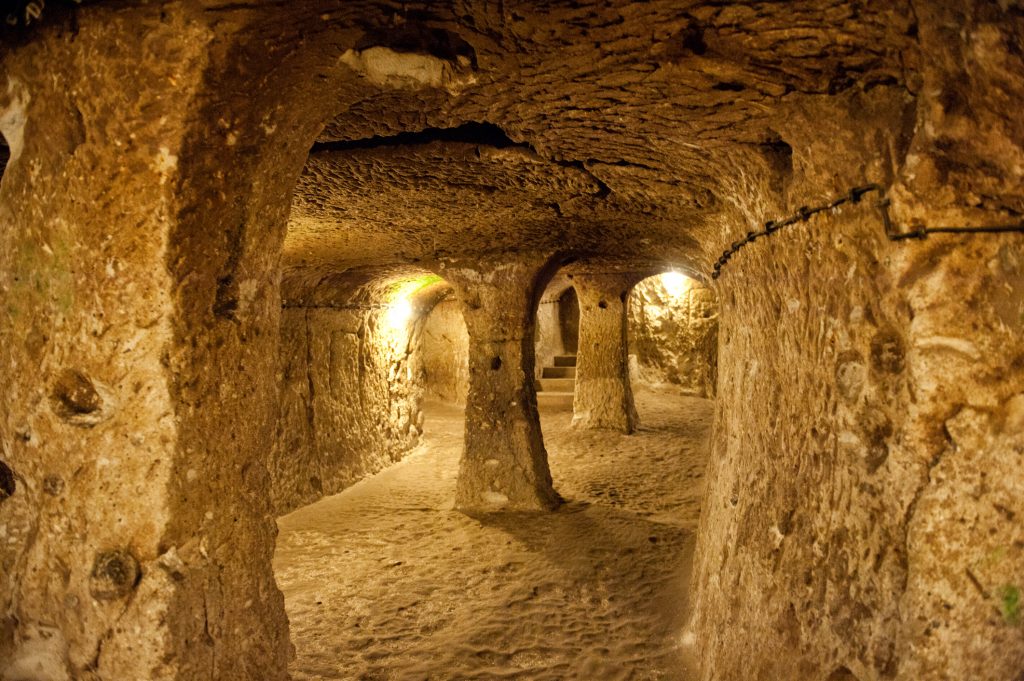It was just a regular day for Mustafa Bozdemir in 1963 as he made renovations to his home in Nevşehir Province, Turkey. That is until Mustafa knocked down a wall of his home and behind it, discovered a whole new room. Connected to this room was an entire city built for nearly twenty-thousand people.1 This city is what became know as Derinkuyu, one of the ancient world’s biggest mysterious.

What we know about who built and lived in the city of Derinkuyu still remains unknown. According to one theory, the city’s beginning dates to 800 B.C.E. when Derinkuyu was built and inhabited first by the Hittites from the Old Kingdom period for an estimated short one-hundred years.2 After the fall of the Hittites around 700 BCE, historians have come to the conclusion that the Phrygians inhabited Derinkuyu.3 Derinkuyu was a sanctuary for the people who lived above ground in the Cappadocia region of modern-day Turkey. The entire region of Cappadocia above Derinkuyu was under constant attack. Since they were under constant attack, this inspired another theory that the majority of the twenty-thousand people who lived within Derinkuyu were refugees from the war between the Arab tribes and Byzantine Christians who were at war overhead around 650 BCE.4

Derinkuyu was equipped with amenities, created with technology far beyond their time. Such amenities included housing for livestock, ventilation chimneys, churches, and schools.5 Archaeologists were baffled by the design of Derinkuyu. The engineering used to build Derinkuyu was with a technology that seems to be from a later time. The cities were carved out of volcanic rock found underground. Since protection was their number one priority, multiple mechanizations were put in place in order to ensure their protection.6 Such mechanization included rolling stone doors to close off various tunnels. In the case of an attack, the rolling stone doors would block any entrances to trap intruders within the tunnel. In the roof of the tunnels, what would appear to be ventilation holes, were actually holes to pour oil on any intruders.7
Derinkuyu was a thriving city for an estimated four-hundred years. Another question historians have about Derinkuyu is what happened to its people? Once Derinkuyu was discovered, it did not take researchers long to learn that it was connected to multiple other underground cities in the surrounding area, including Goreme and Kaymakli.8 Historians have come to the conclusion that Derinkuyu must have been under attack, and people fled to one of the surrounding cities; however, it is still uncertain.

The majority of Derinkuyu’s history may never be known; however, this mysterious city is still an important part of ancient Turkey. Derinkuyu has influenced engineers today to consider the possibility of building underground cities as the population and need for living space continues to grow. Today Derinkuyu has become a tourist attraction for people all over the world.9
- Vladimír Nývlta, Josef Musíleka , JiĜí ýejkab , Ondrej Stopkac, “The Study of Derinkuyu Underground City in Cappadocia Located in Pyroclastic Rock Materials,” Procedia Engineering 161 ( 2016 ): 2253. ↵
- Fitzroy Dearborn, The Hutchinson Dictionary of Ancient and Medieval Warfare (London, UK : Reaktion Books, 2016), 146. ↵
- Benedict Anderson, Buried City, Unearthing Teufelsberg: Berlin and Its Geography of Forgetting ( New York : Routledge, 2017), 13. ↵
- Dig into history, February 2016, s.v. “‘Uncovering’ an underground city,” by Catie Steidl. ↵
- Dobraszczyk, Paul, Galviz, Carlos López, Garrett, Bradley L, Global Undergrounds: Exploring Cities Within (London, UK : Reaktion Books, 2016), 35. ↵
- C. J. Lim, Inhabitable Infrastructures: Science Fiction or Urban Future? (New York, NY: Routledge, 2017), 279. ↵
- Tony Wright, Turn Right at Istanbul: A Walk on the Gallipoli Peninsula (Crows Nest, N.S.W. : Allen & Unwin, 2003), 67. ↵
- Henry Herman, Dominance and Aggression in Humans and Other Animals: The Great Game of Life (London, United Kingdom: Academic Press, 2017), 297. ↵
- Lynn Levine, Frommer’s Turkey: From the Blue Mosque to the Blue Lagoon (3rd ed. Hoboken, NJ : John Wiley & Sons, Inc, 2004), 344. ↵



71 comments
Alexandria Martinez
It is fascinating how, when people or a species in general are in danger, they will always try to figure out how to remain alive. This hidden city is a perfect example, it went unknown for many many years which is amazing. Human beings are so innovative, even way before revolutionary innovations that we have now. This was an interesting article, I had no idea that this city was even a thing and it was nice to learn about human innovations from long ago.
Deanna Lummus
Ancient Turkey is time and place I have never thought about, ever. I never realized how important history could be until a story where we only know so little. Is there anything about them that we could learn and could help us today? We will most likely never know. It is also kind of sad to know that those people’s struggles will never truly be known.
Anthony Robledo
Great introduction! The article made me want to keep reading! Buildings similar to this would be almost impossible to build now, imagine how hard it was back then. Also, imagine living down there. I wouldn’t be able to go a day like that, but they did what they had to in order to survive. You have to ask yourself if it really worked though, because the mystery of what happened to the people is still unsolved. great article!
Benjamin Voy
I have never heard of this underground city in Turkey before however I am now fascinated by it and definitely want to visit. I cannot imagine how Mustafa must have felt when he stumbled across this famous landmark on that day. I actually wonder what happened to his house? Did he have to give it up or does he continue to live there while all the tourists flock through the gates? A very interesting article.
Andrew Rodriguez
This article caught my attention just by the title. Who can resist learning about a underground city mystery. The capacity that the underground could hold was impressive about twenty-thousand people. The building infrastructure was very innovative and commutative thinking. Protecting the people from attacks, creating a safeguard was very smart. It’s very believable that we found out about this place so late was cause of the security it had very discrete I would assume. This article was very insightful and well written.
Edward Cerna
Wow! This is amazing. It is so amazing how they made an entire underground city. Especially a city that houses 20,000 people. This underground really is a miracle. I wonder what Mustafa initially thought when he discovered this huge secret city. This was a great article and I liked the images you used also. The information you gave about who lived in it when and then who lived in it after was really good and I liked it.
Christine Sackey
Great topic choice. It is amazing how advanced the people of Derinkuyu were to come with a whole underground city. I think that it was an incredibly smart thing to do in order to protect themselves and each other. I liked the part about how the underground city was discovered. I cannot imagine renovating my house and discover a whole city was there. It is quite funny.
Sebastian Castro Ramos
How crazy would it be to find a passage to an underground city that once hosted twenty thousand people on your house. I didn’t know that whole underground cities were constructed on that times, and now I imagine it must have taken a great amount of time to construct. It is also sad that people had to literally go underground to hide and protect themselves from war.
Tyler Bradford
I thought this was an intriguing article because this is the first time I have ever heard about this unground cities. It really strikes my curiosity as to how they were able to build elaborate pathways in general and then to build it all underground is honestly mind blowing. It also makes me wonder when did they have the time to build all of it. It must have taken a long time, especially given the fact that they were under constant attack. I’m also curious about their mysterious disappearance. If they had these underground pathways and cities, where exactly could they have gone.
Josselyn Arrieta-Meraz
I’ve hear of underground tunnels but never actual cities that were actually thriving at a time and that were done with a purpose of protection. These people were so advanced in technology in a way that makes you question what else they knew, Derinkuyu seems like such a unique city that is filled with secrets and innovations of the people. Such a good read, sometimes you don’t realize what people had to do at times to stay alive and creating an underground city created a new record.